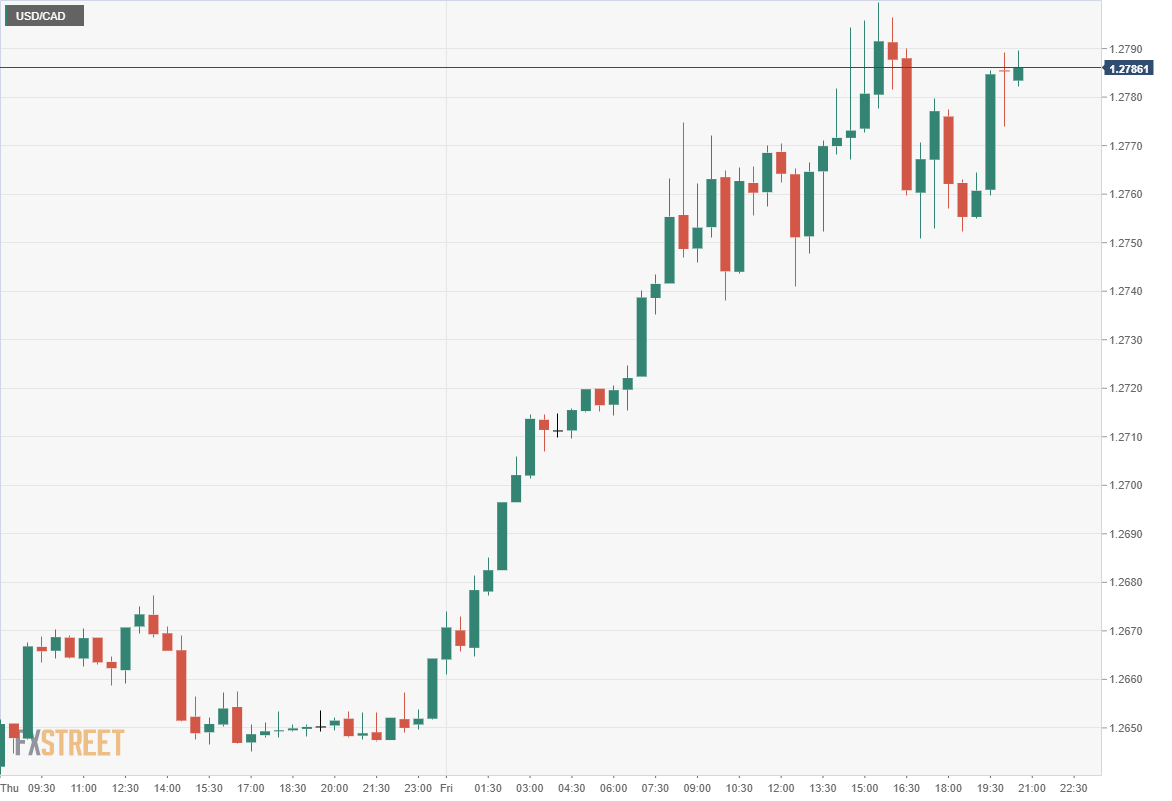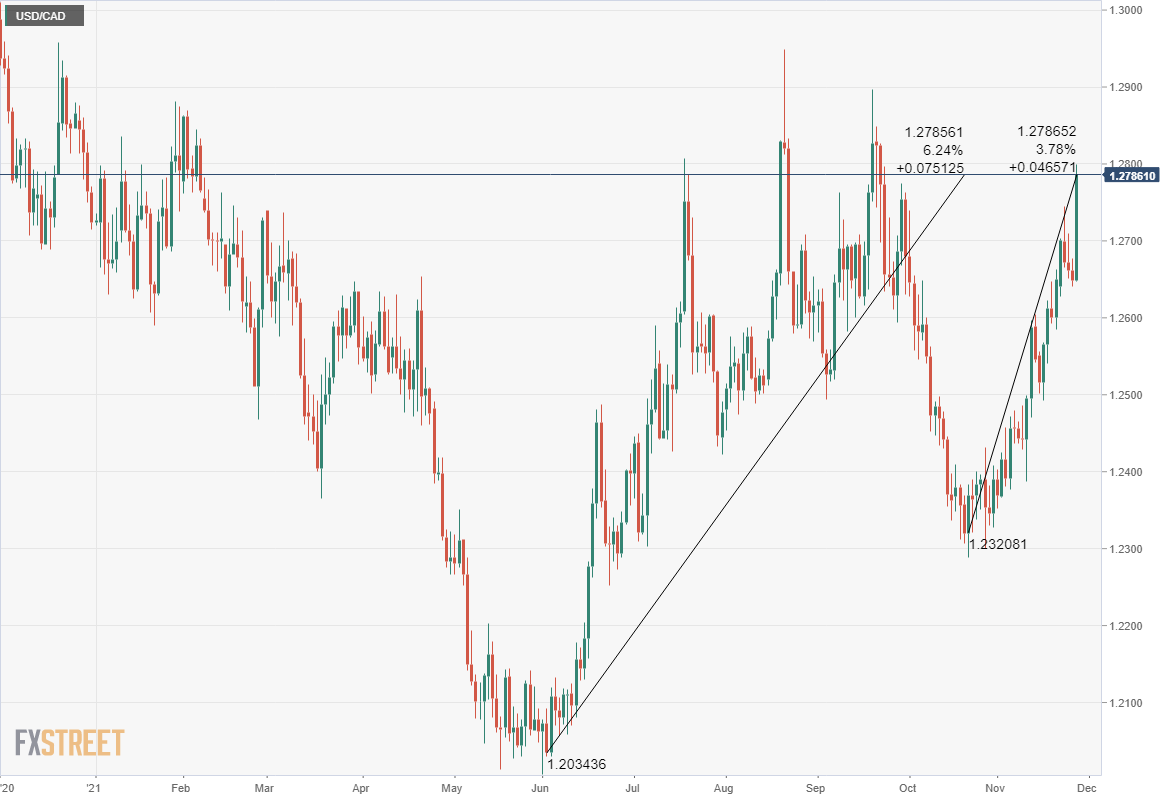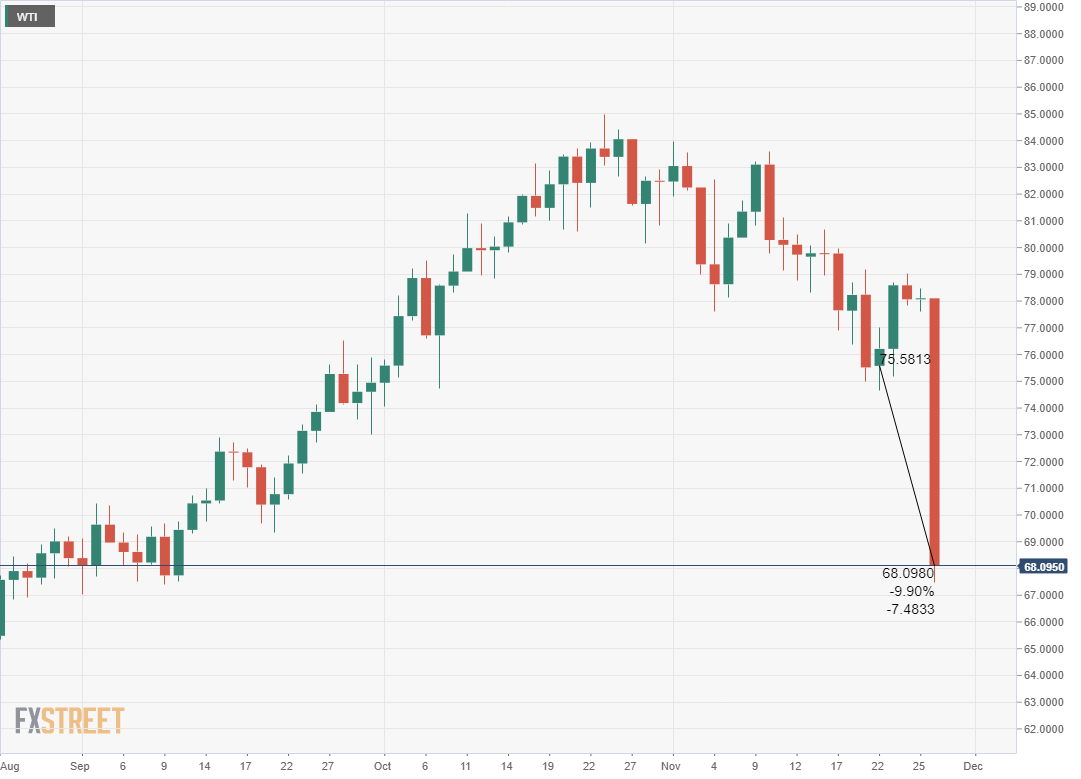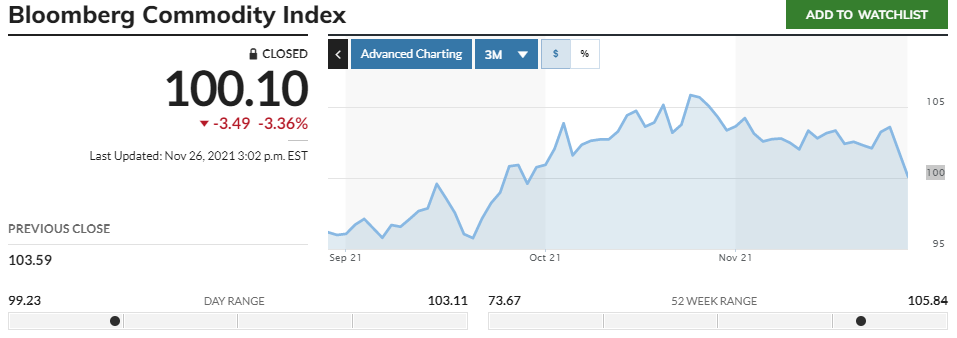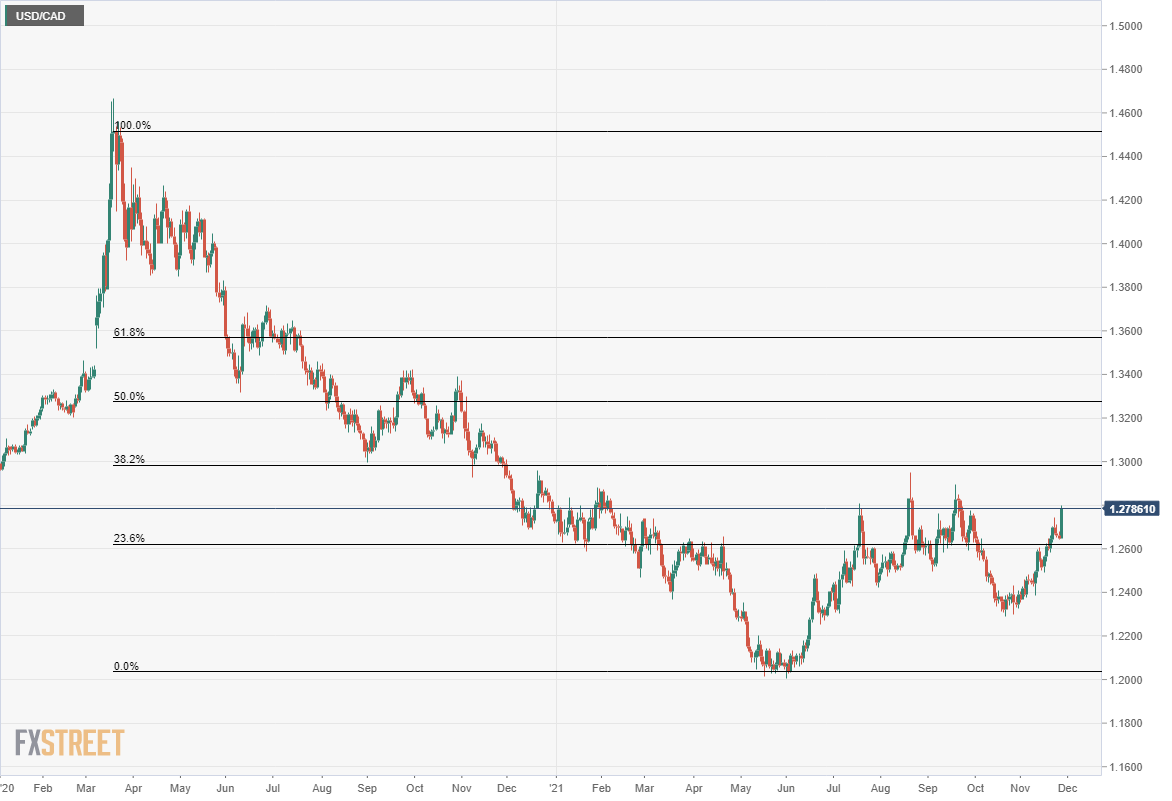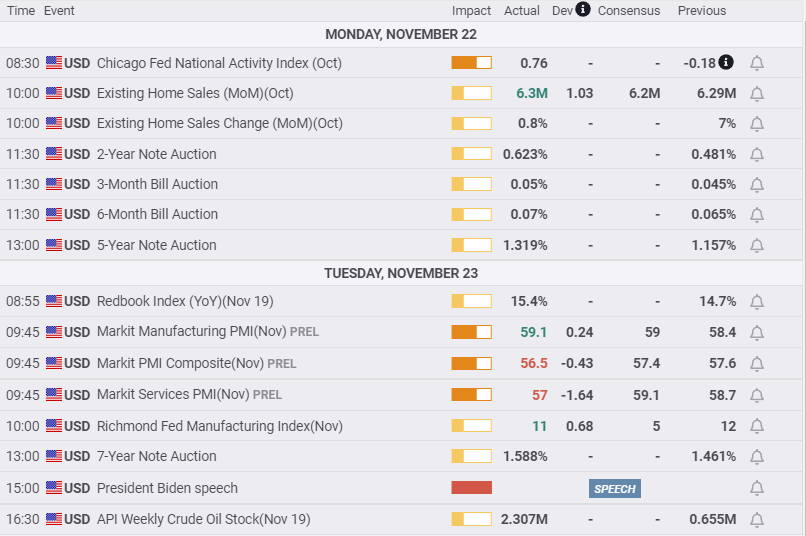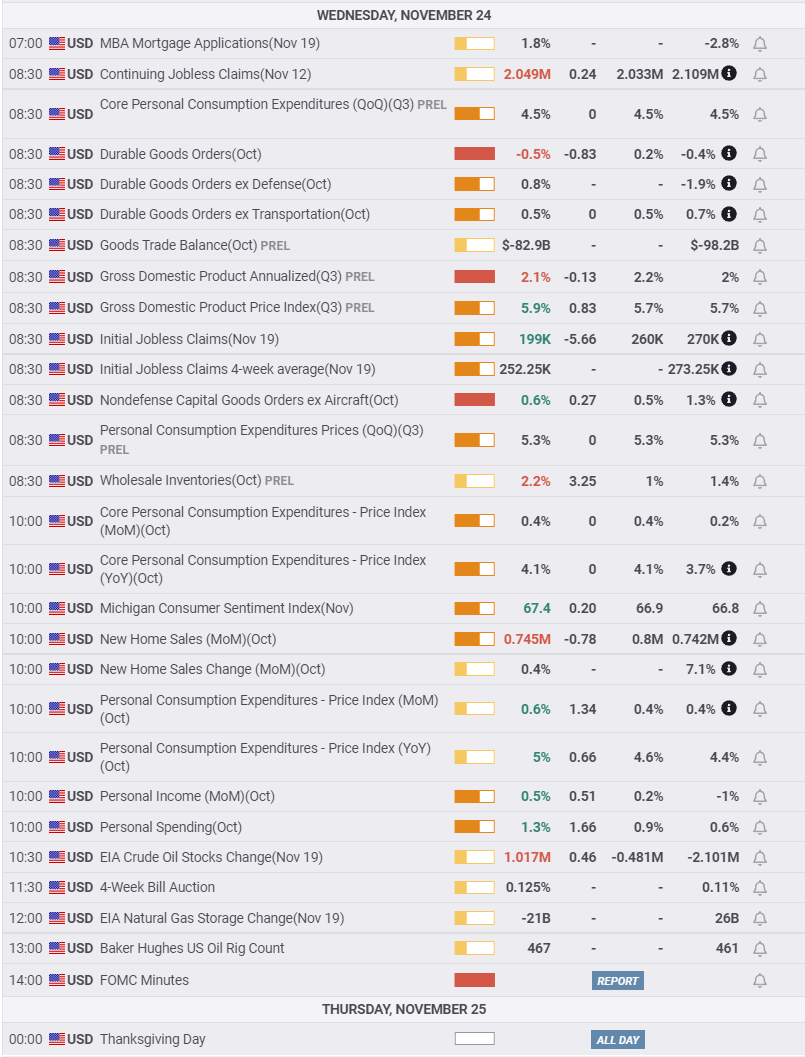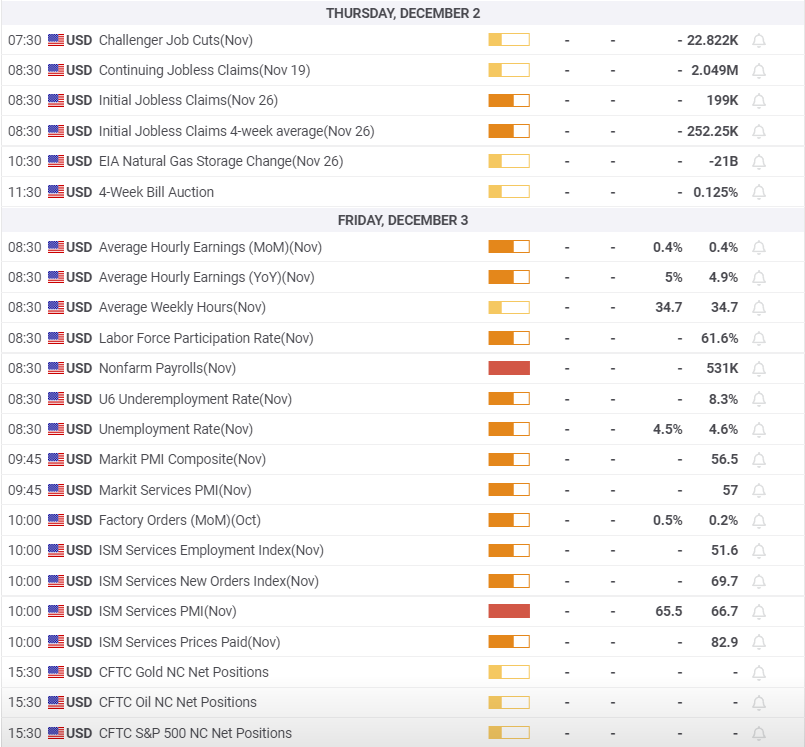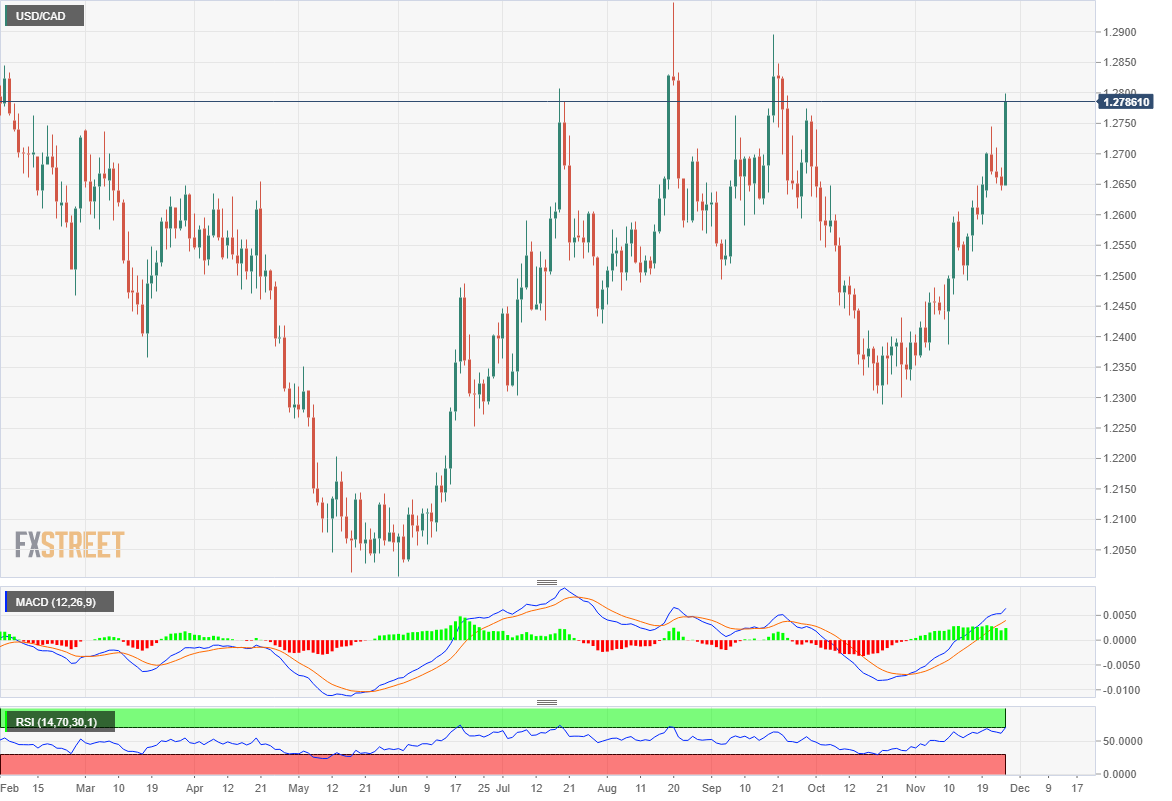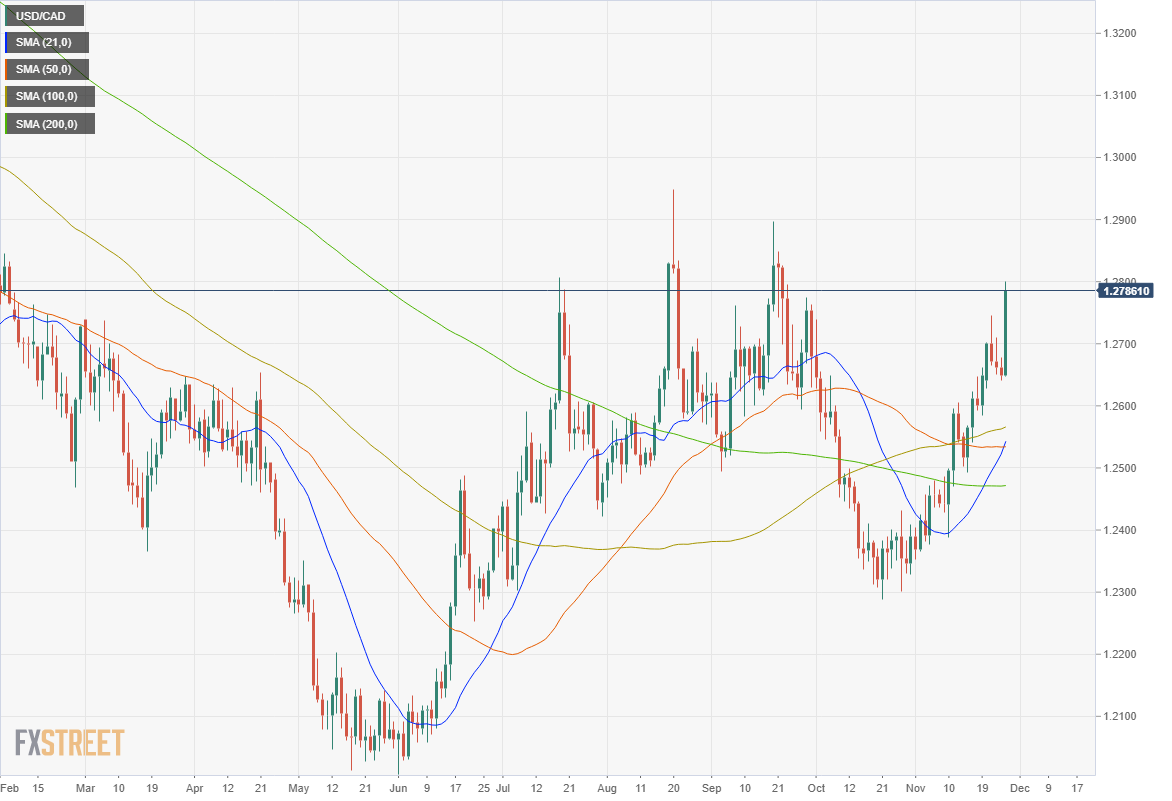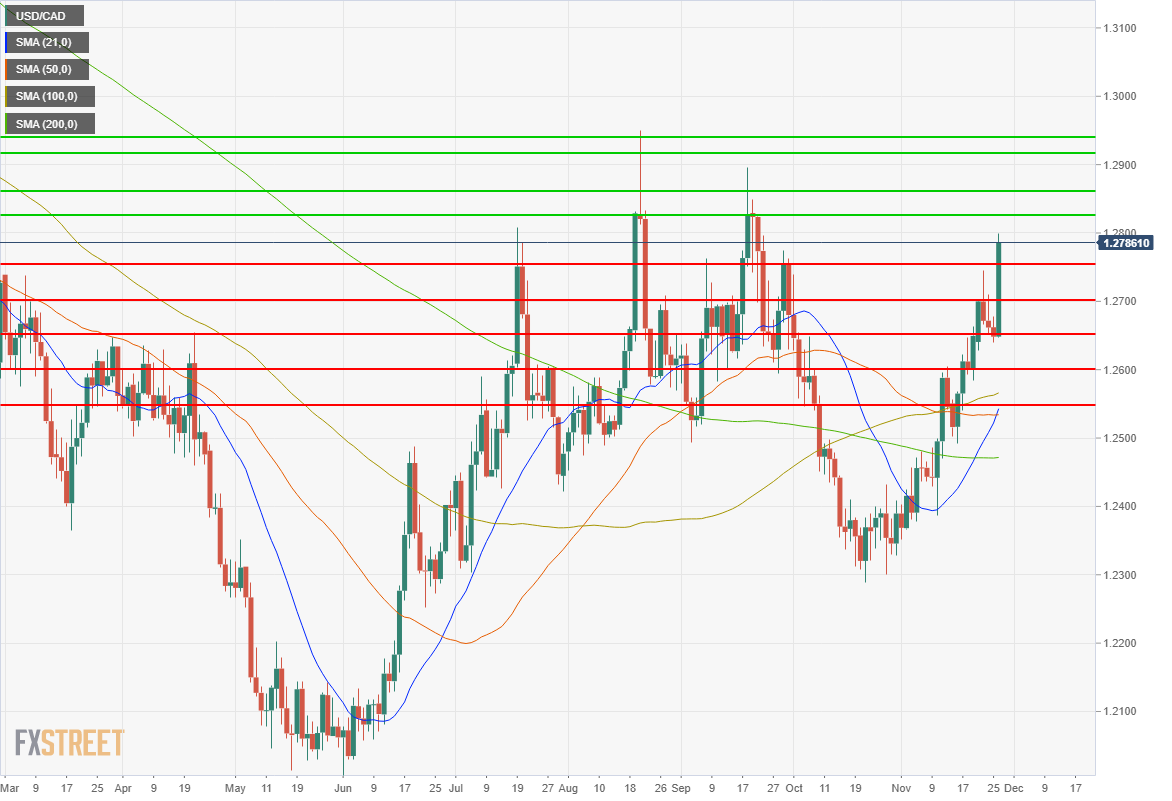- New COVID variant, Omicron, first-discovered in South Africa, roils global markets.
- WTI falls 10% from Monday’s open, 12.8% on Friday, commodities plunge.
- USD/CAD adds 1%, closes at two-month high despite US Treasury yield decline.
- FXStreet Forecast Poll predicts near-term neutrality.
The discovery of a new COVID variant in South Africa amplified fears about the economic impact of the already spreading viral cases in Europe and completely upended global markets on Friday. Travel restrictions on South Africa and neighbor countries by the US, UK and others underlined the perceived danger.
The ensuing equity and commodity sell-off and safe-haven demand punished the Canadian dollar which dropped to its lowest level against its US counterpart in two months.
Dollar-Canada* opened the week at 1.2641 and by the end of trading in Thursday’s US holiday market had barely stirred to 1.2648. Friday’s global equity and commodity sell-off on fears that the new COVID variant and the ensuing restrictive mandates will crush the economic recovery, drove crude oil prices to their largest single day fall since April 2020.
Dollar-Canada moved higher at the beginning of Friday's market, encountered some resistance above 1.2750, touched 1.2800, its highest trade since September 22 and settled at 1.2768, a two-month high, up 1.1% on the day.
The USD/CAD has gained 3.8% from its open at 1.2320 on October 22 and 6.2% from its low of 1.2035 onJune 2.
West Texas Intermediate (WTI), the North American crude pricing standard, lost 12.8% on the day ($78.10-468.09) and 10% on the week ($75.58-$68.09).
The Bloomberg Commodity Index (BCOM) fell 3.36% on Friday and closed at 100.10, down 5.42% from the seven-year high of 105.84 on October 25.
Bloomberg/MarketWatch
American equities took a huge beating with the Dow losing 2.53%, 905.04 points to 34,899.34. The S&P 500 tumbled 106.84 points, 2.27%, finishing at 4.594.62.
Sovereign interest rates tumbled on Friday as investors anticipated future central bank accommodation should the new variant prove dangerous.
The Canadian 10-year bond yield lost 16 basis points to 1.605% and the yield on the US 10-year Treasury also shed 16 basis points to 1.482%.
There were no Canadian economic statistics this week.
In the United States, the Core Personal Consumption Expenditure Price Index – core PCE for short – the Fed’s preferred inflation measure, came in at 4.1% (YoY) in October, well above the 3.7% prediction and the highest annual rate since January 1991. The headline PCE rate soared 5%, the fastest gain since November 1990.
Personal Spending, a broader gauge of consumption than Retail Sales, rose 1.3% from 0.6% in September. Excluding the stimulus fueled months of January and March this year, it was the best score since July 2020.
The Fed initiated the withdrawal from its monthly $120 billion bond purchases at its November 3 meeting. A reduction of $15 billion is scheduled for November and December, with continuing subtractions expected until the program is eliminated in June.
Accelerating inflation makes the need for higher US interest rates plain. Core PCE has nearly tripled this year from 1.5% in January, and the overall rate has soared 3.5 times from 1.4%.
Manufacturing costs are also rocketing, guaranteeing that yet higher prices will be passed onto consumers. The Producer Price index jumped 8.6% in October, its highest level in 13 years.
Economic growth fell sharply in the third quarter to 2.1% from 6.5% in the first half of the year. If expansion continued at that pace in the fourth quarter, the Fed governors might be hard pressed to justify higher interest rates despite the inflationary surge.
The Federal Open Market Committee (FOMC) does not want to be forced to choose between curbing inflation and growth.
Fortunately for the bankers, the American consumer is ignoring inflation and spending at levels that should keep the economy humming through to the end of the year.
The latest Atlanta Fed GDPNow estimate for the final three months of the year is 8.6%. If accurate, that would provide 5.9% growth for the year.
In addition to the Personal Spending and PCE data discussed above, several other US statistics intimated a healthy economy. Initial Jobless Claims dropped to 199,000 in the week of November 19, far below the 260,000 forecast and the lowest number since November 1969. Even in the heady expansion of late 2019 and early 2020, the lowest reading was 201,000 in the week of January 31. Personal Income, a more encompassing gauge of family finances than Average Hourly Earnings, that includes transfer payments, interest income and other non-salary items, rose 0.5% in October, more than twice its 0.2% forecast and a reversal of the 1% September decrease. Wholesale Inventories rose 2.2% in October, up from 1.4% in September and one reason for the rising GDP estimates for the fourth quarter.
*Currency market terminology for USD/CAD
USD/CAD outlook
The USD/CAD has not overcome crucial resistance at 1.2825 centered on the high finishing trades in August and September. Thursday’s close at 1.2648 was 27 points above the 23.6% Fibonacci retracement level (1.2621) of the March 2020 (1.4514) to June 2021 (1.2035) USD/CAD decline. The September to November drop was partially due to the inability to approach the 38.2% Fibonacci retracement line at 1.2983.
Fundamentally, the drop in oil prices is a large impediment to robust growth in the Canadian economy. The Bank of Canada (BOC) has an aggressive rate normalization policy, having already ended its bond purchases. If the global recovery recedes because of a new series of government lockdowns, whether from the Delta-wave or some other variant, Canada’s resource based economy will not prosper. The BOC will be unable to continue its push for higher rates until growth resumes.
Canadian Gross Domestic Product (GDP) for September and annualized for the third quarter on Thursday will not move trading. The Employment Change Report on Friday will, as usual, be subsumed in the US payroll release at the same time.
The speculation that US rate policy is about to shift was given backing in the minutes of the November 3 FOMC meeting released on Wednesday. The summary noted that bank officials were concerned about inflation and would be willing to raise interest rates “sooner than participants currently anticipated”, with some advocating a more aggressive tapering program.
The appointment of Jerome Powell as Federal Reserve Chair is another plus for the dollar. His competitor for the post, now Vice-Chair, Lael Brainard, was viewed by markets as a bit more accommodating, though there is probably little reason to doubt that in practice, her policies would have been nearly identical.
In the US, Nonfarm Payrolls have the potential to send the dollar and interest rates higher. The relationship is linear, better payrolls, higher Treasury yields and the dollar. Purchasing Managers’ Indexes for the manufacturing and services sectors will also provide the greenback with support if they show an accelerating US economy.
The USD/CAD bias is higher with the large caveat that if the newest South African variant proves to be little different in consequence than previous versions, Friday’s rampant moves will reverse. That will not negate the basic USD/CAD trend higher, but it will weaken momentum and could result in a period of relative neutrality.
Canada statistics November 22–November 26
US statistics November 22–November 26
FXStreet
Canada statistics November 29–November 26
FXStreet
US statistics November 29–December 3
USD/CAD technical outlook
The MACD (Moving Average Convergence Divergence) has favored the USD/CAD since the main line crossed the signal line on October 28. The divergence dipped on Thursday but widened again on Friday. It remains a purchase. The Relative Strength Index (RSI) borders on overbought status, and so stays a buy, if a wary one.
Three moving averages clustered within 32 points midway between 1.2500 and 1.2600 are a source of major support. The 21-day moving average (MA) at 1.2543, the 50-day MA at 1.2534 and the 100-day MA at 1.2566 indicate a base for upward movement. The 200-day MA at 1.2472 is a strong backup.
Resistance: 1.2825, 1.2860, 1.2915, 1.2940
Support: 1.2755, 1.2700, 1.2650, 1.2600
FXStreet Forecast Poll
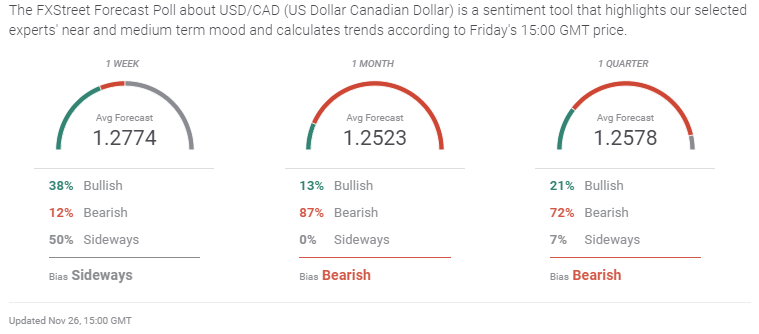
The immediate balancing of forces in the USD/CAD is evident in the FXStreet Forecast Poll.
Information on these pages contains forward-looking statements that involve risks and uncertainties. Markets and instruments profiled on this page are for informational purposes only and should not in any way come across as a recommendation to buy or sell in these assets. You should do your own thorough research before making any investment decisions. FXStreet does not in any way guarantee that this information is free from mistakes, errors, or material misstatements. It also does not guarantee that this information is of a timely nature. Investing in Open Markets involves a great deal of risk, including the loss of all or a portion of your investment, as well as emotional distress. All risks, losses and costs associated with investing, including total loss of principal, are your responsibility. The views and opinions expressed in this article are those of the authors and do not necessarily reflect the official policy or position of FXStreet nor its advertisers. The author will not be held responsible for information that is found at the end of links posted on this page.
If not otherwise explicitly mentioned in the body of the article, at the time of writing, the author has no position in any stock mentioned in this article and no business relationship with any company mentioned. The author has not received compensation for writing this article, other than from FXStreet.
FXStreet and the author do not provide personalized recommendations. The author makes no representations as to the accuracy, completeness, or suitability of this information. FXStreet and the author will not be liable for any errors, omissions or any losses, injuries or damages arising from this information and its display or use. Errors and omissions excepted.
The author and FXStreet are not registered investment advisors and nothing in this article is intended to be investment advice.
Recommended Content
Editors’ Picks
EUR/USD holds above 1.0650 after US data

EUR/USD retreats from session highs but manages to hold above 1.0650 in the early American session. Upbeat macroeconomic data releases from the US helps the US Dollar find a foothold and limits the pair's upside.
GBP/USD retreats toward 1.2450 on modest USD rebound

GBP/USD edges lower in the second half of the day and trades at around 1.2450. Better-than-expected Jobless Claims and Philadelphia Fed Manufacturing Index data from the US provides a support to the USD and forces the pair to stay on the back foot.
Gold clings to strong daily gains above $2,380

Gold trades in positive territory above $2,380 on Thursday. Although the benchmark 10-year US Treasury bond yield holds steady following upbeat US data, XAU/USD continues to stretch higher on growing fears over a deepening conflict in the Middle East.
Ripple faces significant correction as former SEC litigator says lawsuit could make it to Supreme Court

Ripple (XRP) price hovers below the key $0.50 level on Thursday after failing at another attempt to break and close above the resistance for the fourth day in a row.
Have we seen the extent of the Fed rate repricing?

Markets have been mostly consolidating recent moves into Thursday. We’ve seen some profit taking on Dollar longs and renewed demand for US equities into the dip. Whether or not this holds up is a completely different story.
